Category: Landscape design of a personal plot, decorating a garden with your own hands Published 03/18/2013 · Comments: · Reading time: 3 min · Views: 369
Probably every summer resident dreams of a tree that will be the accent of the entire garden, decorative all year round. It can be a tree with a weeping form. It looks amazingly elegant and romantic and delights you with flowers in spring, a cascade of leaves in summer, bright colors of leaves and fruits in autumn, and beautiful branches in winter.
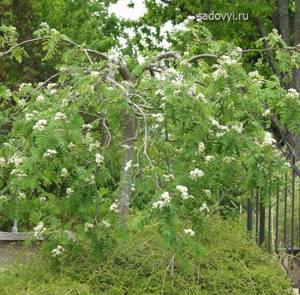
Weeping trees are especially impressive near ponds or in a Japanese garden (where a weeping willow or maple is an integral element of the garden, setting the mood). They can be a wonderful backdrop for a flower garden, form romantic alleys, or serve as a shady, cozy canopy for a bench.
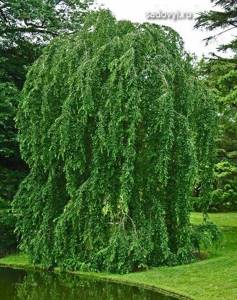
Description of the plant
There are many forms of wood in nature. They come in both huge species and small shrubs. We have about 100 of them growing.
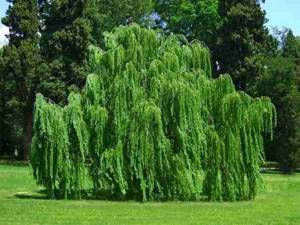
Willow is interesting for its decorative properties. It has a through and transparent crown, which reaches 25 meters. The trunk is strong with gray bark. At first, the crown of the tree has a columnar shape, which over time becomes spreading and wide. The branches are thin and very flexible. Their bark can be light, green, or purple. The shoots are directed upwards, and the side shoots hang down. Petiolate leaves are alternately located on them. The leaf shape is elliptical; some species are characterized by being long and narrow. The color of the foliage is dark green, the bottom is lighter or bluish. The flowers are inconspicuous in the form of earrings. Their flowering begins before the growth of foliage in early spring. The fruit is formed in the form of a box with small seeds, pubescent on top. They are capable of being transported by wind over long distances.
Willow: how to plant a cutting correctly
This can be done in the fall, when the leaves have fallen from the trees, and in the spring, when consistently warm weather has established, but the growing season has not yet actively begun. Before planting the willow, a depression is made; it should be no closer than half a meter from another row of trees and from neighbors in the row. The “hole” is pierced with a rod to the length of the handle, and the ground around it is trampled or compacted. A seedling is inserted into it and covered tightly with soil.
We will have to act somewhat differently in the fall. Firstly, you won’t be able to get by with a simple hole. The planting site is dug up to a diameter of three meters and cleared of weeds (this is especially true for perennials with strong roots - nettle, sow thistle, and sow thistle). A hole about a cubic meter in volume is being dug. The bottom is lined with sawdust or bark, sprinkled with fungicide against pests and seasoned with potassium nitrate - to increase survival in the winter. Compost is laid out on top, a seedling is placed, sprinkled with soil and mulched.
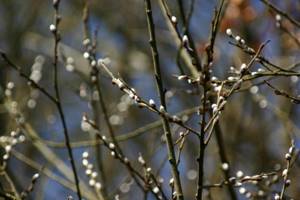
Common types of willow and their pruning
The tree tolerates pruning well. It is carried out after the plant grows about a meter. All shoots are cut to 30 centimeters. Typically, the procedure is best done in the spring. Trees that are actively growing are also pruned in the summer. And so, in the summer, only dead shoots are removed. As a result of pruning, the willow tree becomes attractive, and its bark thickens.
Most often, the following species are grown in our parks and require special formative pruning:
- White willow. Frost-resistant powerful species with a shapeless crown. It is formed by straight branches, with extending drooping shoots. The tree forms a crown on its own, but due to uneven growth it can break, so it is formed in the early stages. Pruning helps distribute branches evenly. For this purpose, a young tree is cut into a stump so that pronounced shoots are formed.
The tree is formed as a standard tree. The main trunk is left and all buds that form below two meters are removed. The excess ones located above are removed evenly. Once you have the tree's skeleton properly formed, minor pruning will be needed later.
To grow a tree with spectacularly colored shoots, you need to prune it every year into a stump, or into a standard. Its height will vary from half a meter to one and a half meters, it all depends on the desired effect.
The shape and height of pruning are established in the early stages, since adult specimens react poorly to large wounds, because these places are subject to infection with rot, and hollows form there.
If it is necessary to remove dangerously located large branches from a tree, then the procedure should be performed by a professional; if a similar situation occurs again, it is better to cut off the old tree and plant young trees. White willow is considered the largest species
- Goat willow. Frost-resistant tree with an umbrella-shaped crown. This species is compact and slow growing. In the spring, it forms many male earrings. Mostly weeping standard trees are sold. They are a cultivated form that is grafted onto a cleaned stem. Its height is on average 1.5 meters. This species does not require pruning in order to form a crown; it is enough to simply trim it so that it does not thicken and fall to the ground.
During maintenance annual pruning, half the branches are removed, creating airy foliage. These shoots will grow to the ground at the end of the growing season. It is also necessary to thin out the branches in the middle of the crown, so that an end-to-end canopy in the form of an umbrella is formed. Next, the side shoots that are located from the outside are removed. The remaining branches are shortened to half the size. In the spring, when active growth of shoots begins, all traces of pruning will be disguised. All buds that appear in areas below the graft must be removed.
- Mourning willow. This is a conical frost-resistant type. It is a hybrid of white willow and Babylonian willow. Interesting with bright green foliage and yellow shoots.
In young animals, they try to form a strong trunk with horizontally located branches. They can withstand a stem height of 1.5 to 2 meters. As the willow grows, the central shoot is shortened so that the crown expands and acquires a weeping appearance. Over the years, the tree grows in height due to individual shoots directed upward, but they gradually begin to droop over the course of the year. They should not be removed, since direct growth is a temporary phenomenon. Every year a new shoot will appear, which is why the crown gradually becomes cascading. When the tree is fully formed, there will be little pruning. It is necessary to thin them out so that light and air can get inside the plant. This strengthens the side branches, their weight gradually increases as the crown grows in width. Deep pruning does not work well on willow.
Step-by-step instructions for propagation and transplantation
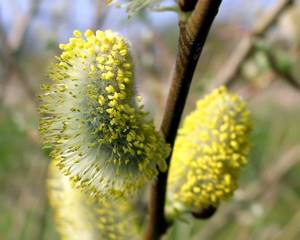
So, how to grow a tree from a branch? Let’s formulate the question more precisely: how to grow a willow from a branch and what will be needed for this? Let's break down the process step by step:
- Planting material is prepared when pruning the mother tree. Harvesting is carried out in the off-season (February for spring work, November for autumn planting). This is important, since at this time the plant’s sap flow naturally slows down;
- Shoots 2-3 years old are suitable for planting . Younger cuttings may not take root;
- The cutting is carried out in the middle section of the uterine branch. The length of the shoot must be at least 30 centimeters;
- The cutting takes root in water with the addition of heteroauxin for several days until you notice small white shoots at the end. Cut the cuttings obliquely, so rooting goes faster;
- The prepared branches are planted in the ground for growing in a mini-greenhouse or greenhouse. The distance between plantings is 25 – 30 cm.
Before planting in the ground, the willow branch must be thoroughly strengthened. This, as mentioned above, will take about 11 – 12 months or even longer (depending on the condition of the plant).
What kind of weeping trees are there?
The weeping form of a tree can be formed in 2 ways: natural and artificial. The artificial crown is either formed in various ways or grafted onto a standard. Some species of willows, birches, and rowan trees have a natural “weeping” quality.
Almost all trees with flexible branches or vines are suitable for the artificial formation of weeping forms. Especially such as: goat willow, silver birch, rowan, willow pear, caragana tree (aka yellow acacia), hazel, rowan, linden, apple, larch, pine, spruce. You can even grow vines (roses, wisteria, etc.) on a trunk, creating weeping forms.
For the tree to survive
When the willow gets a little accustomed to its new place, you need to water it (if there are no rainfalls or a natural source of water) at least twice a week. In the first year, the tree is regularly, twice a month, fed with mineral nitrogen and liquid organic matter. A couple of times a season it is worth pollinating both it and the ground around it with a pest repellent. If you want to form a bush, and a bushier one, bend the lower branches to the ground, secure them with flyers and sprinkle them with fertile soil and compote. The branches will take root and form additional stems.
Formation of a weeping crown
The process of tree formation is quite extended over time. The final beautiful form is acquired in 8-10 years.
To form a weeping form, you need to very carefully tilt the young branches in the desired direction. To do this you will need rope and stiff wire. The wire is bent in the direction of the bend of the branch and tied with a rope. The branches are fixed in the desired direction without excessive zeal and very carefully so as not to damage the bark or break it. The fixation is removed when the branch becomes woody and takes a stationary position, usually by autumn if it was formed in the spring. The branches are fixed in the desired direction without excessive zeal and very carefully so as not to damage the bark or break it. For wintering, it is better to use a rope so that the cold wire does not scratch the bark.
Weeping form formed on a trunk
The trunk is the trunk of a tree from the root to the first lower branches. Branches from a tree that has a weeping shape are grafted onto a tall trunk (at least 180 cm). It should be taken into account that the standard will practically not stretch upward, only in width.
How to graft branches? To do this, a smooth oblique cut is made on the scion with a sharp knife to the core at the lower end. On the reverse side, the tip of the branch is cleaned more bluntly. A split is made on the trunk using a sharp knife and hammer. The scion branches are wedged into the split of the trunk. The grafting site is tightly tied with electrical tape or braid and filled with garden varnish.
Choosing a place
So, you have a seedling or you have prepared a cutting yourself, and you are interested in a full-fledged, lush willow. How to plant material so as not to lose it? First of all, choose a suitable site. It should not be brightly lit: willow loves shade. So it can take a place near the northern wall of the house, usually unclaimed due to the scarcity of sun. As already mentioned, the plant is moisture-loving. And not every site has a body of water. But often in the countryside there are lowlands - and this is the best place for willow. No less successful for it will be the proximity of a compost or cesspool - there is always high humidity there. In any case, the tree will have to be watered often, unless the summer is rainy. But the composition of the soil is indifferent to him; it does not have to be fertile and rich. But acidity is important: alkaline soils will have to be acidified.
Willow care
The degree of care depends on the type of willow, planting location and climate. But basically it comes down to two actions:
Watering
If the summer is dry, do not spare water to water the willow tree. We water ours every season, even if it’s not very hot. Sometimes we use buckets, and sometimes we just throw a hose under it for a while. And it feels great! Even in nature, willows grow best along rivers and reservoirs. They are not afraid of small floods in the spring. It’s a pity that the summer photos of our willow were not preserved...
A haircut
This applies only to decorative low-growing willows. Trimming gives these trees a special flavor.
Trimming gives these trees a special flavor.
And if you don’t cut it, then why plant decorative varieties? So don’t be lazy to shape the crown. The branches are thin, there won't be any problems with cutting. But I like regular willows better. They are also very different. That's what we'll talk about next.











